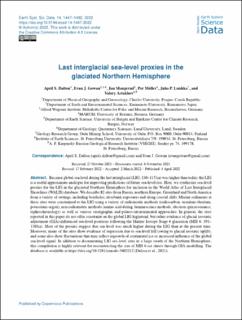| dc.contributor.author | Dalton, A.S. | |
| dc.contributor.author | Gowan, Evan J. | |
| dc.contributor.author | Mangerud, Jan | |
| dc.contributor.author | Möller, Per | |
| dc.contributor.author | Lunkka, J.P. | |
| dc.contributor.author | Astakhov, Valery i. | |
| dc.date.accessioned | 2022-06-10T08:17:40Z | |
| dc.date.available | 2022-06-10T08:17:40Z | |
| dc.date.created | 2022-04-09T11:54:44Z | |
| dc.date.issued | 2022 | |
| dc.identifier.issn | 1866-3508 | |
| dc.identifier.uri | https://hdl.handle.net/11250/2998262 | |
| dc.description.abstract | Because global sea level during the last interglacial (LIG; 130–115 ka) was higher than today, the LIG is a useful approximate analogue for improving predictions of future sea-level rise. Here, we synthesize sea-level proxies for the LIG in the glaciated Northern Hemisphere for inclusion in the World Atlas of Last Interglacial Shorelines (WALIS) database. We describe 82 sites from Russia, northern Europe, Greenland and North America from a variety of settings, including boreholes, riverbank exposures and along coastal cliffs. Marine sediments at these sites were constrained to the LIG using a variety of radiometric methods (radiocarbon, uranium–thorium, potassium–argon), non-radiometric methods (amino acid dating, luminescence methods, electron spin resonance, tephrochronology) as well as various stratigraphic and palaeo-environmental approaches. In general, the sites reported in this paper do not offer constraint on the global LIG highstand, but rather evidence of glacial isostatic adjustment (GIA)-influenced sea-level positions following the Marine Isotope Stage 6 glaciation (MIS 6; 191–130 ka). Most of the proxies suggest that sea level was much higher during the LIG than at the present time. Moreover, many of the sites show evidence of regression due to sea-level fall (owing to glacial isostatic uplift), and some also show fluctuations that may reflect regrowth of continental ice or increased influence of the global sea-level signal. In addition to documenting LIG sea-level sites in a large swath of the Northern Hemisphere, this compilation is highly relevant for reconstructing the size of MIS 6 ice sheets through GIA modelling. The database is available at https://doi.org/10.5281/zenodo.5602212 (Dalton et al., 2021). | en_US |
| dc.language.iso | eng | en_US |
| dc.publisher | Copernicus Publications | en_US |
| dc.rights | Navngivelse 4.0 Internasjonal | * |
| dc.rights.uri | http://creativecommons.org/licenses/by/4.0/deed.no | * |
| dc.title | Last interglacial sea-level proxies in the glaciated Northern Hemisphere | en_US |
| dc.type | Journal article | en_US |
| dc.type | Peer reviewed | en_US |
| dc.description.version | publishedVersion | en_US |
| dc.rights.holder | Copyright 2022 The Author(s) | en_US |
| cristin.ispublished | true | |
| cristin.fulltext | original | |
| cristin.qualitycode | 1 | |
| dc.identifier.doi | https://doi.org/10.5194/essd-14-1447-2022 | |
| dc.identifier.cristin | 2016328 | |
| dc.source.journal | Earth System Science Data | en_US |
| dc.source.pagenumber | 1447-1492 | en_US |
| dc.relation.project | Norges forskningsråd: 255415 | en_US |
| dc.identifier.citation | Earth System Science Data. 2022, 14, 1447-1492. | en_US |
| dc.source.volume | 14 | en_US |

